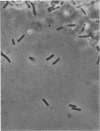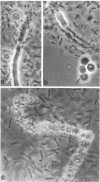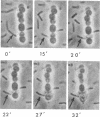Abstract
Enrichment from local fishponds led to the isolation of a bacterium capable of lysing many species of unicellular and filamentous blue-green algae, as well as certain bacteria. The isolate is an aflagellate, motile rod which moves in a gliding, flexuous manner; the organism is capable of digesting starch and agar, but not cellulose and gelatin. Its deoxyribonucleic acid base pair composition (per cent guanine plus cytosine ∼70) shows a close resemblance to that of the fruiting myxobacteria. Algae in lawns on agar plates were lysed rapidly by the myxobacter, but only limited and slow lysis occurred in liquid media, and no lysis took place when liquid cultures were shaken. No diffusible lytic factors would be demonstrated. Continuous observation of the lytic process under a phase-contrast microscope suggested that a close contact between the polar tip of the myxobacter and the alga is necessary for lysis. The lytic action is limited to the vegetative cells of the algae, whereas heterocysts are not affected. The gas vacuoles of the algal host are the only remnant visible after completion of digestion by the myxobacter.
Full text
PDF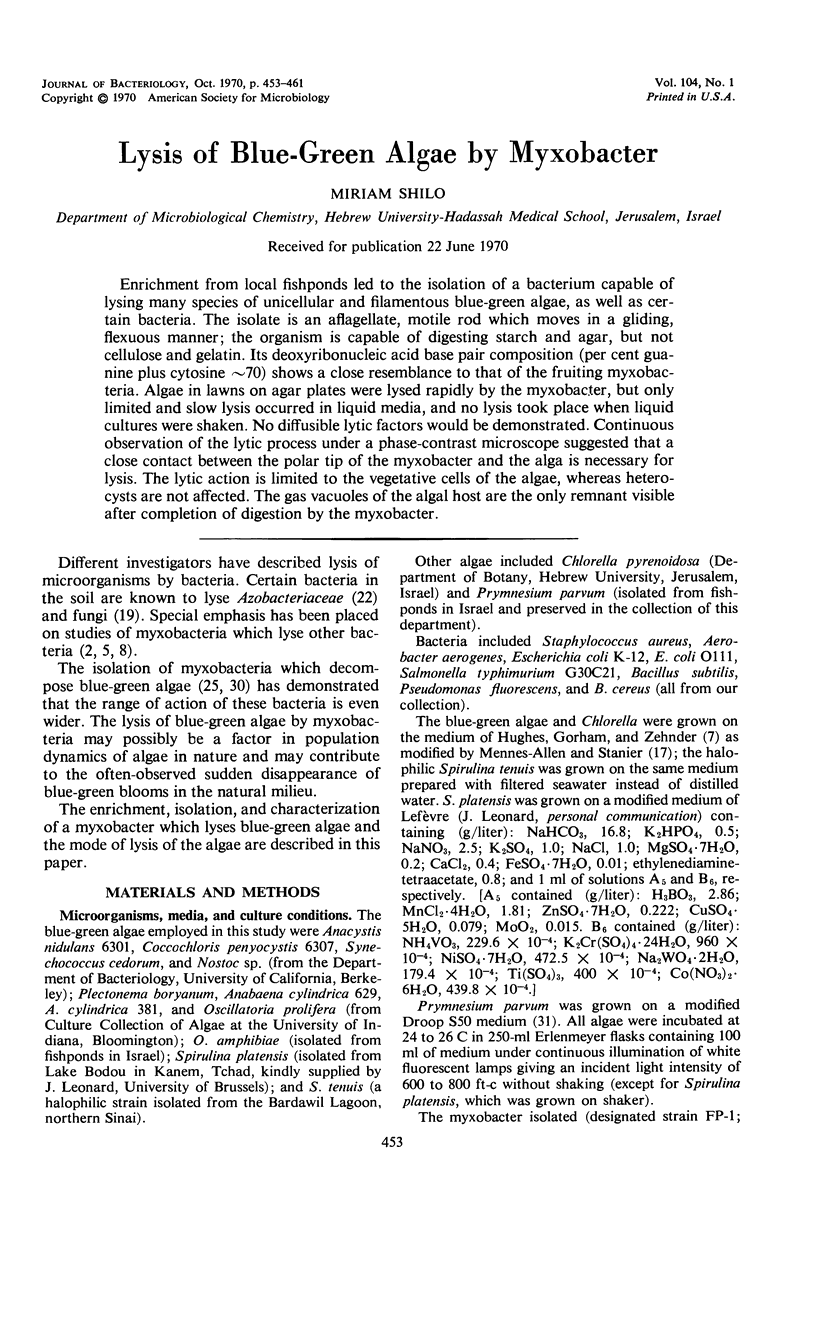
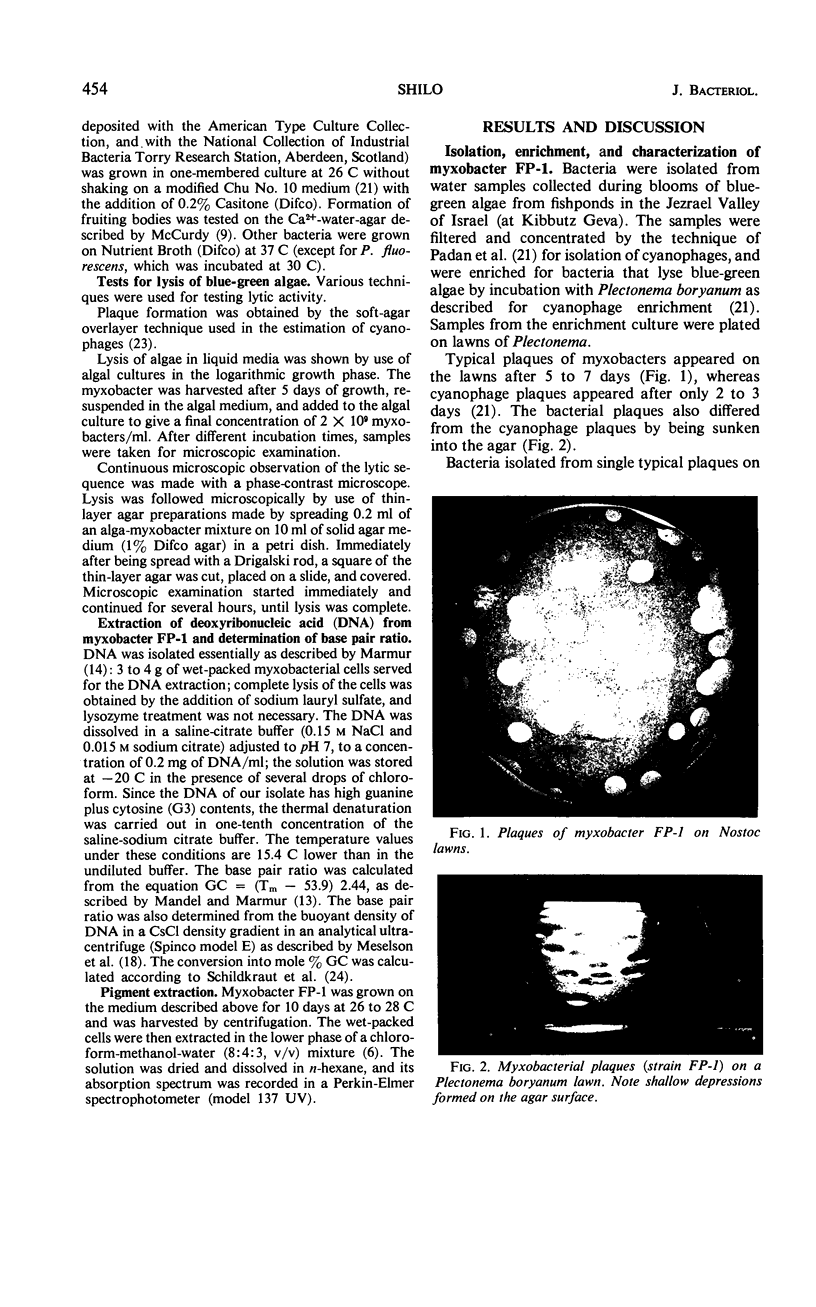
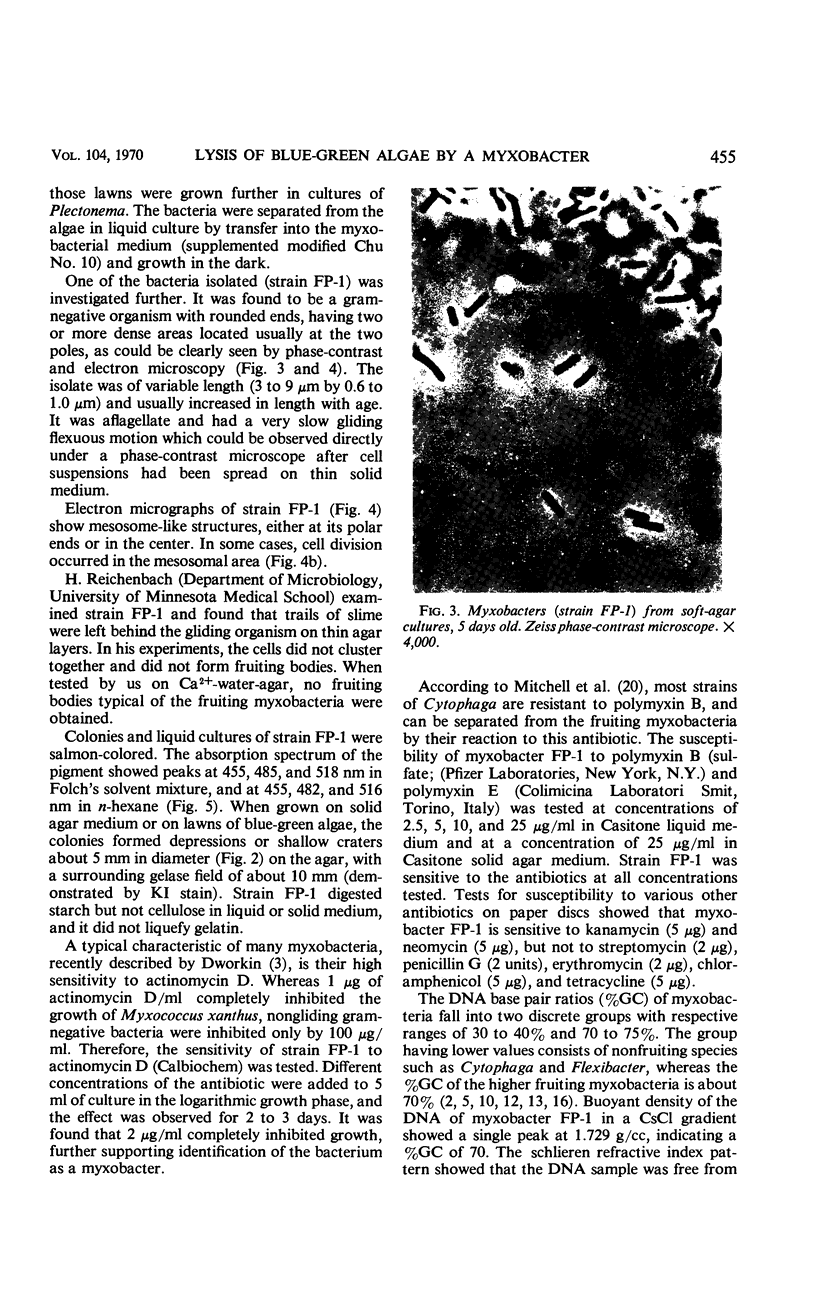
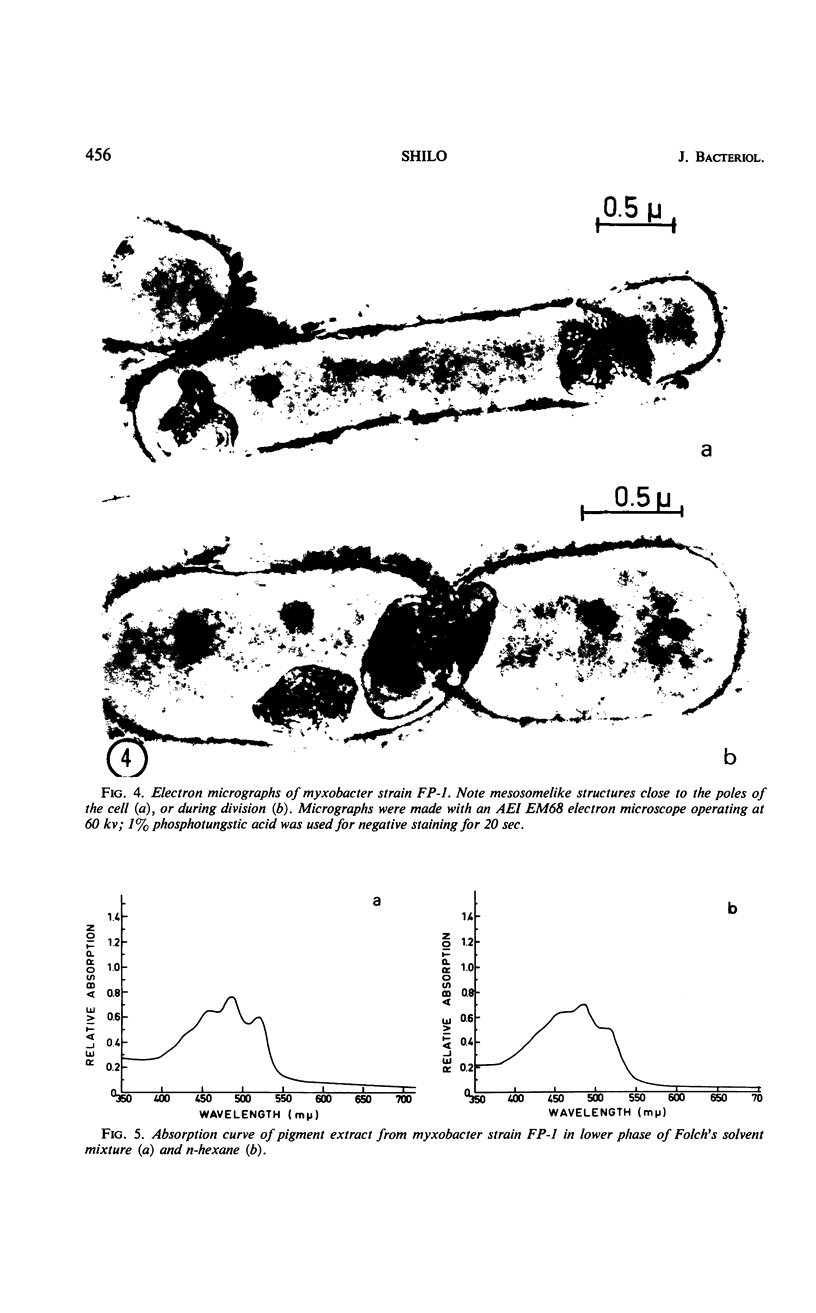
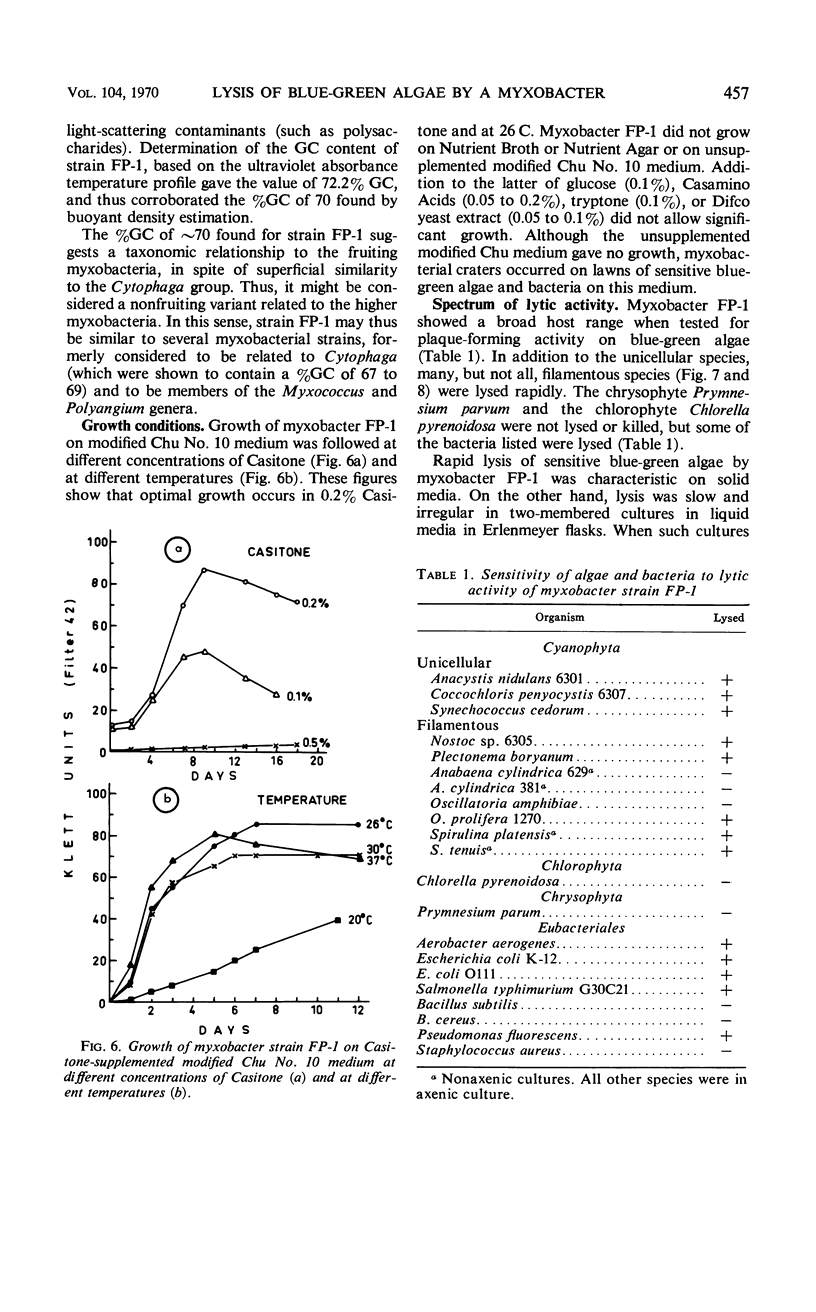
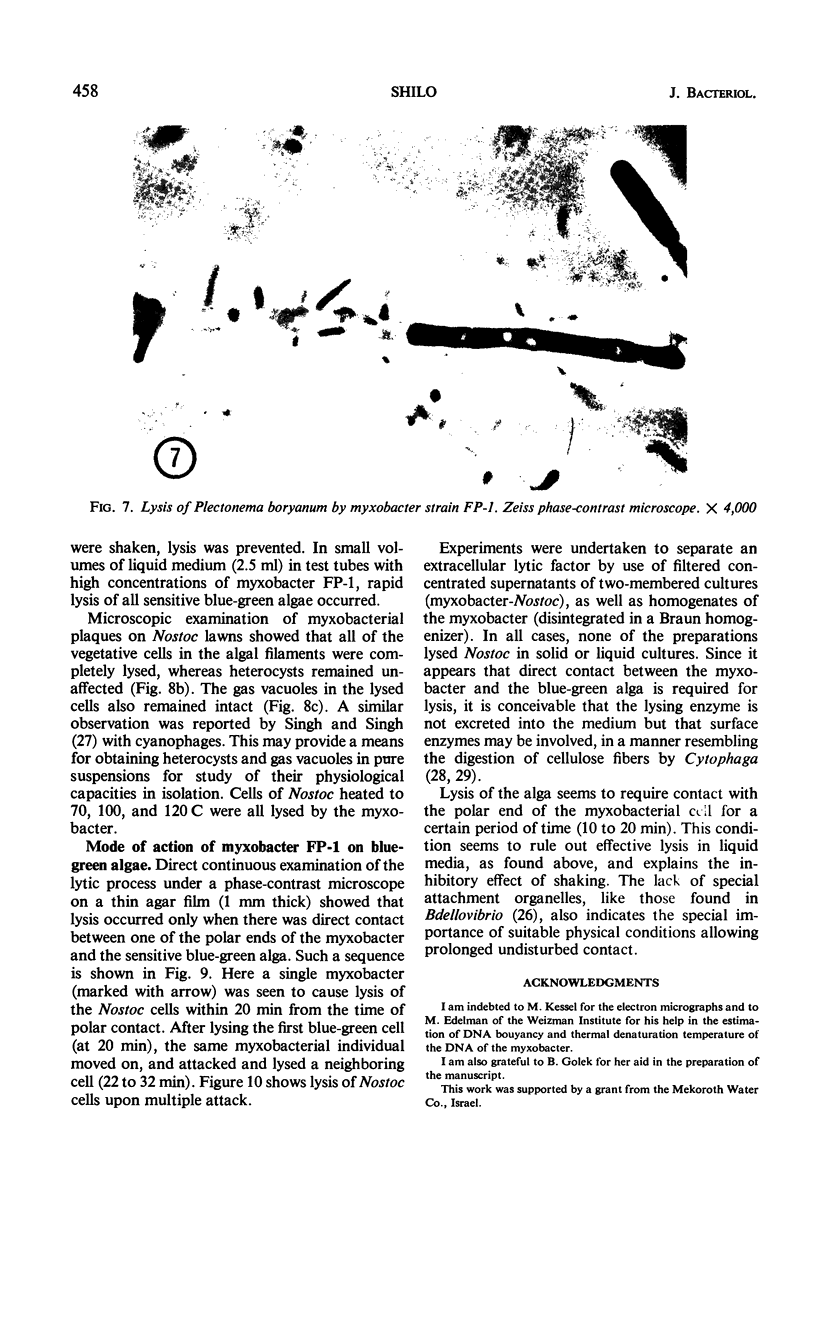
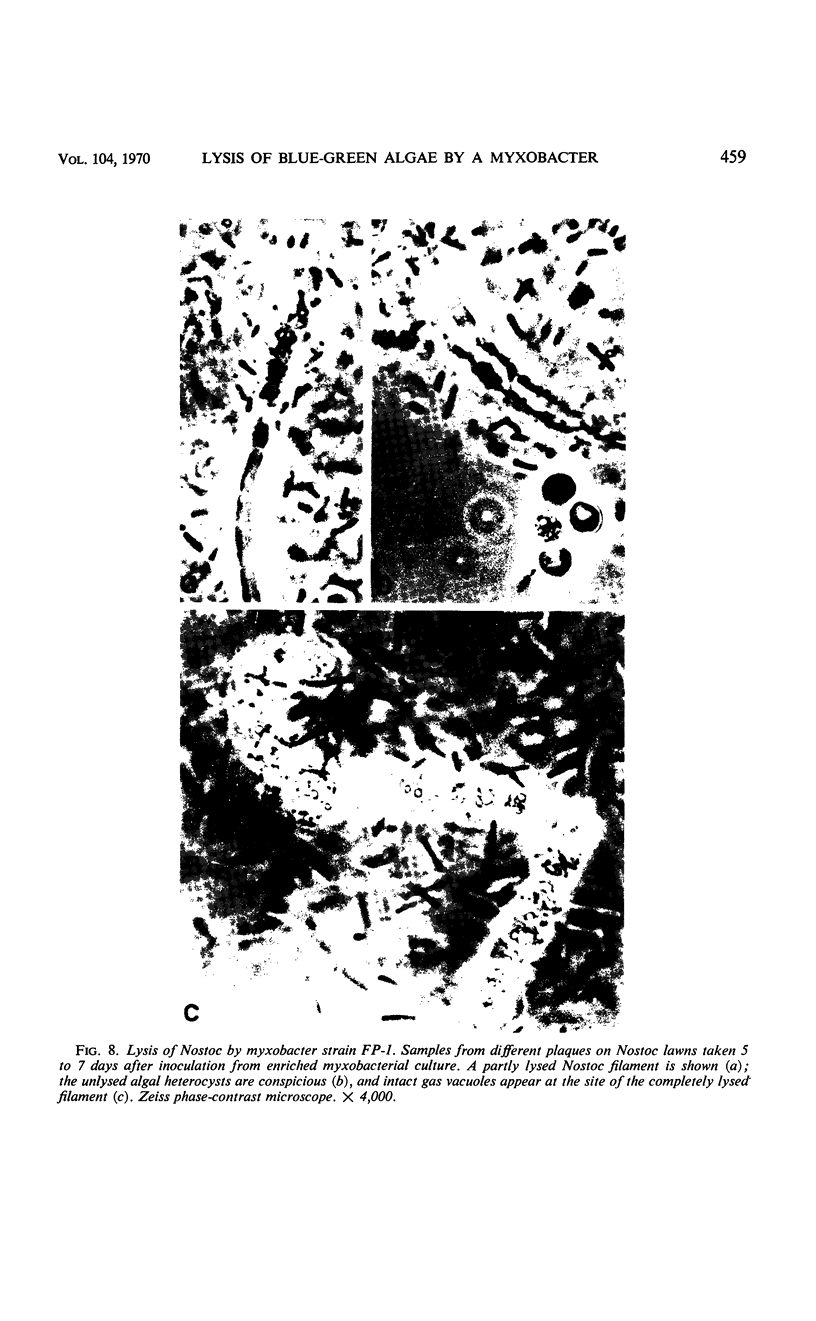
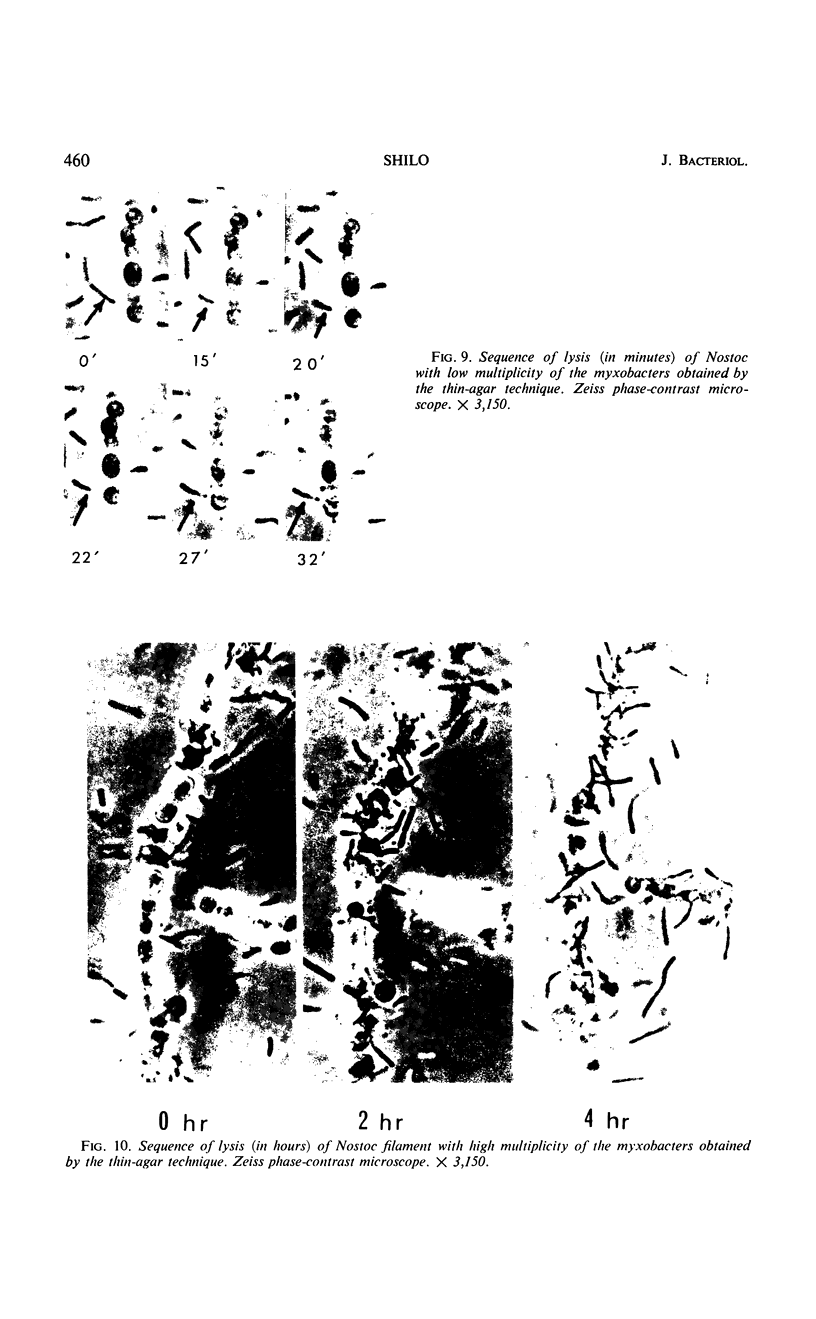
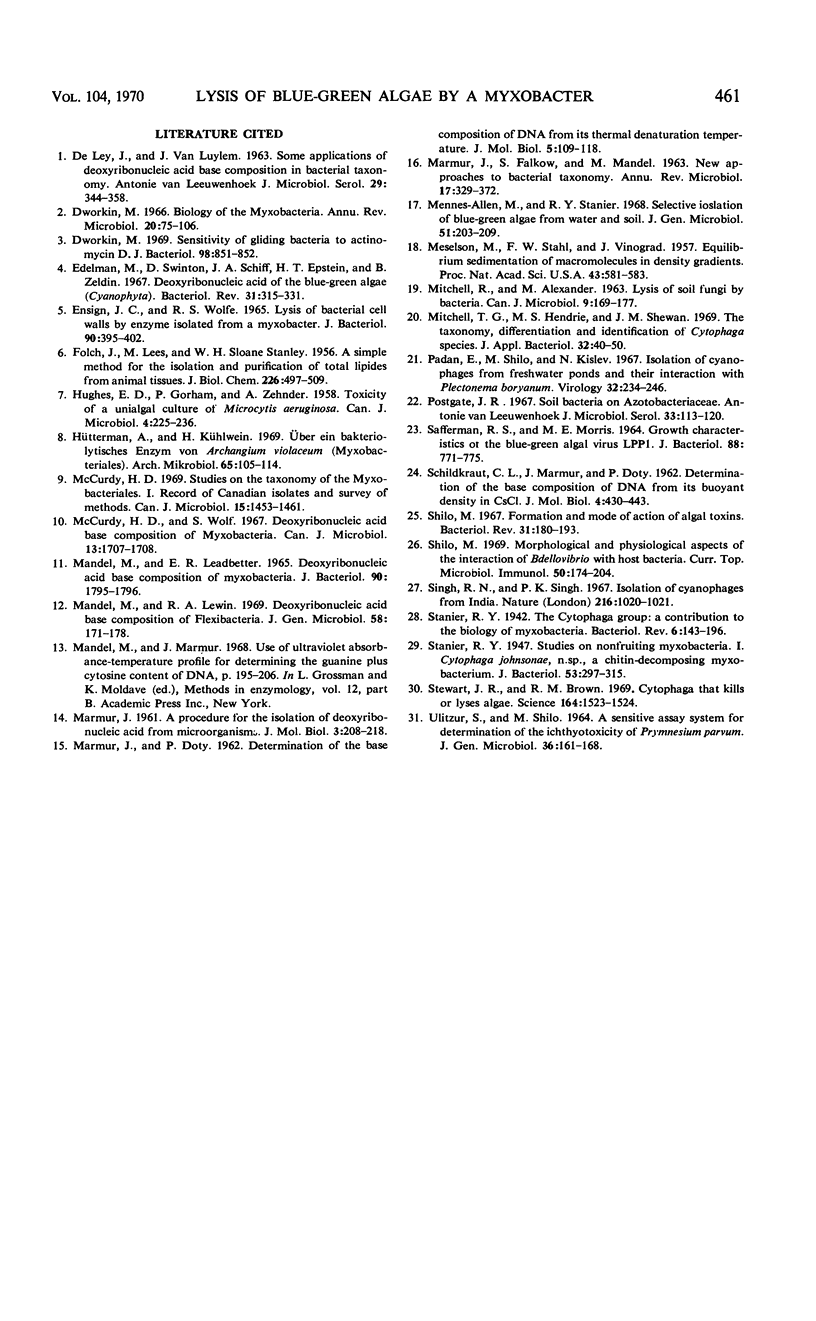
Images in this article
Selected References
These references are in PubMed. This may not be the complete list of references from this article.
- Allen M. M., Stanier R. Y. Selective isolation of blue-green algae from water and soil. J Gen Microbiol. 1968 Apr;51(2):203–209. doi: 10.1099/00221287-51-2-203. [DOI] [PubMed] [Google Scholar]
- DELEY J., VANMUYLEM J. SOME APPLICATIONS OF DEOXYRIBONUCLEIC ACID BASE COMPOSITION IN BACTERIAL TAXONOMY. Antonie Van Leeuwenhoek. 1963;29:344–358. doi: 10.1007/BF02046087. [DOI] [PubMed] [Google Scholar]
- Dworkin M. Biology of the myxobacteria. Annu Rev Microbiol. 1966;20:75–106. doi: 10.1146/annurev.mi.20.100166.000451. [DOI] [PubMed] [Google Scholar]
- Dworkin M. Sensitivity of gliding bacteria to actinomycin D. J Bacteriol. 1969 May;98(2):851–852. doi: 10.1128/jb.98.2.851-852.1969. [DOI] [PMC free article] [PubMed] [Google Scholar]
- ENSIGN J. C., WOLFE R. S. LYSIS OF BACTERIAL CELL WALLS BY AN ENZYME ISOLATED FROM A MYXOBACTER. J Bacteriol. 1965 Aug;90:395–402. doi: 10.1128/jb.90.2.395-402.1965. [DOI] [PMC free article] [PubMed] [Google Scholar]
- Edelman M., Swinton D., Schiff J. A., Epstein H. T., Zeldin B. Deoxyribonucleic Acid of the blue-green algae (cyanophyta). Bacteriol Rev. 1967 Dec;31(4):315–331. doi: 10.1128/br.31.4.315-331.1967. [DOI] [PMC free article] [PubMed] [Google Scholar]
- FOLCH J., LEES M., SLOANE STANLEY G. H. A simple method for the isolation and purification of total lipides from animal tissues. J Biol Chem. 1957 May;226(1):497–509. [PubMed] [Google Scholar]
- HUGHES E. O., GORHAM P. R., ZEHNDER A. Toxicity of a unialgal culture of Microcystis aeruginosa. Can J Microbiol. 1958 Jun;4(3):225–236. doi: 10.1139/m58-024. [DOI] [PubMed] [Google Scholar]
- Hüttermann A., Kühlwein H. Uber ein bakteriolytisches Enzym von Archangium violaceum (Myxobacteriales). I. Messungen in vivo. Arch Mikrobiol. 1969;65(2):105–114. [PubMed] [Google Scholar]
- MARMUR J., DOTY P. Determination of the base composition of deoxyribonucleic acid from its thermal denaturation temperature. J Mol Biol. 1962 Jul;5:109–118. doi: 10.1016/s0022-2836(62)80066-7. [DOI] [PubMed] [Google Scholar]
- MARMUR J., FALKOW S., MANDEL M. NEW APPROACHES TO BACTERIAL TAXONOMY. Annu Rev Microbiol. 1963;17:329–372. doi: 10.1146/annurev.mi.17.100163.001553. [DOI] [PubMed] [Google Scholar]
- Mandel M., Leadbetter E. R. Deoxyribonucleic acid base composition of myxobacteria. J Bacteriol. 1965 Dec;90(6):1795–1796. doi: 10.1128/jb.90.6.1795-1796.1965. [DOI] [PMC free article] [PubMed] [Google Scholar]
- Mandel M., Lewin R. A. Deoxyribonucleic acid base composition of flexibacteria. J Gen Microbiol. 1969 Oct;58(2):171–178. doi: 10.1099/00221287-58-2-171. [DOI] [PubMed] [Google Scholar]
- McCurdy H. D. Studies on the taxonomy of the Myxobacterales. I. Record of Canadian isolates and survey of methods. Can J Microbiol. 1969 Dec;15(12):1453–1461. doi: 10.1139/m69-259. [DOI] [PubMed] [Google Scholar]
- McCurdy H. D., Wolf S. Deoxyribonucleic acid base compositions of fruiting Myxobacterales. Can J Microbiol. 1967 Dec;13(12):1707–1708. doi: 10.1139/m67-222. [DOI] [PubMed] [Google Scholar]
- Meselson M., Stahl F. W., Vinograd J. EQUILIBRIUM SEDIMENTATION OF MACROMOLECULES IN DENSITY GRADIENTS. Proc Natl Acad Sci U S A. 1957 Jul 15;43(7):581–588. doi: 10.1073/pnas.43.7.581. [DOI] [PMC free article] [PubMed] [Google Scholar]
- Mitchell T. G., Hendrie M. S., Shewan J. M. The taxonomy, differentiation and identification of Cytophaga species. J Appl Bacteriol. 1969 Mar;32(1):40–50. doi: 10.1111/j.1365-2672.1969.tb02187.x. [DOI] [PubMed] [Google Scholar]
- Padan E., Shilo M., Kislev N. Isolation of "cyanophages" from freshwater ponds and their interaction with Plectonema boryanum. Virology. 1967 Jun;32(2):234–246. doi: 10.1016/0042-6822(67)90273-5. [DOI] [PubMed] [Google Scholar]
- Postgate J. R. Soil bacteria parasitic on Azotobacteriaceae. Antonie Van Leeuwenhoek. 1967;33(1):113–120. doi: 10.1007/BF02045541. [DOI] [PubMed] [Google Scholar]
- SAFFERMAN R. S., MORRIS M. E. GROWTH CHARACTERISTICS OF THE BLUE-GREEN ALGAL VIRUS LPP-1. J Bacteriol. 1964 Sep;88:771–775. doi: 10.1128/jb.88.3.771-775.1964. [DOI] [PMC free article] [PubMed] [Google Scholar]
- SCHILDKRAUT C. L., MARMUR J., DOTY P. Determination of the base composition of deoxyribonucleic acid from its buoyant density in CsCl. J Mol Biol. 1962 Jun;4:430–443. doi: 10.1016/s0022-2836(62)80100-4. [DOI] [PubMed] [Google Scholar]
- Shilo M. Formation and mode of action of algal toxins. Bacteriol Rev. 1967 Sep;31(3):180–193. doi: 10.1128/br.31.3.180-193.1967. [DOI] [PMC free article] [PubMed] [Google Scholar]
- Shilo M. Morphological and physiological aspects of the interaction of Bdellovibrio with host bacteria. Curr Top Microbiol Immunol. 1969;50:174–204. doi: 10.1007/978-3-642-46169-9_6. [DOI] [PubMed] [Google Scholar]
- Stanier R. Y. Studies on Nonfruiting Myxobacteria: I. Cytophaga johnsonae, n.sp., a Chitin-decomposing Myxobacterium. J Bacteriol. 1947 Mar;53(3):297–315. [PMC free article] [PubMed] [Google Scholar]
- Stanier R. Y. THE CYTOPHAGA GROUP: A CONTRIBUTION TO THE BIOLOGY OF MYXOBACTERIA. Bacteriol Rev. 1942 Sep;6(3):143–196. doi: 10.1128/br.6.3.143-196.1942. [DOI] [PMC free article] [PubMed] [Google Scholar]
- Stewart J. R., Brown R. M., Jr Cytophaga that kills or lyses algae. Science. 1969 Jun 27;164(3887):1523–1524. doi: 10.1126/science.164.3887.1523. [DOI] [PubMed] [Google Scholar]
- ULITZUR S., SHILO M. A SENSITIVE ASSAY SYSTEM FOR DETERMINATION OF THE ICHTHYOTOXICITY OF PRYMNESIUM PARVUM. J Gen Microbiol. 1964 Aug;36:161–169. doi: 10.1099/00221287-36-2-161. [DOI] [PubMed] [Google Scholar]





